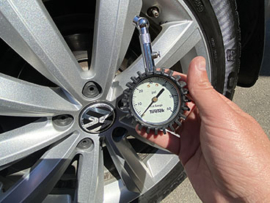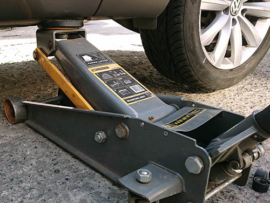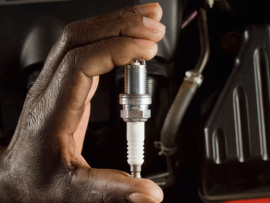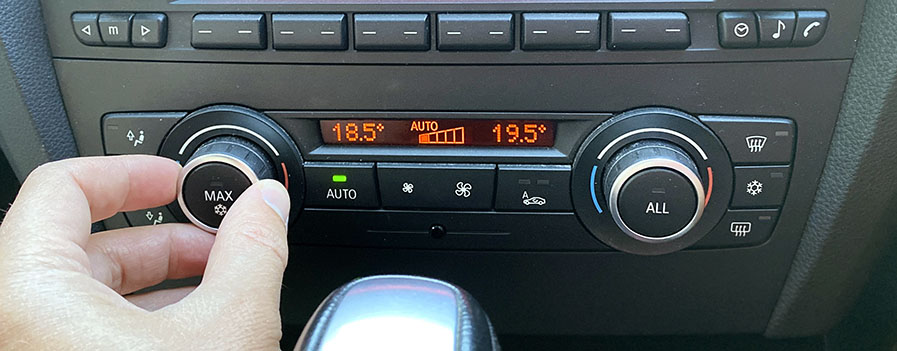
Not only has the internal combustion engine (ICE) delivered efficient transport for over a hundred years, it’s also blessed travelers with a level of comfort never dreamed of in earlier times when animal driven vehicles were the norm.
Take for instance cabin heating. Once exposed to the vagaries of the elements, clever use of the ICE’s cooling system now affords travelers cabin-heating on demand. By routing the ICE’s heated coolant through a heat exchanger in the passenger compartment, commuters are offered a means to control the cabin temperature in cold or inclement weather.
Usually located behind the dashboard on the passenger’s side of the compartment, the heat exchanger, commonly referred to as a heater core or heater box, resembles a small radiator that warms the car’s interior with the heat extracted from the vehicle’s cooling system.
Understanding The Heater Core and How it Works
Similar to the radiator in design, the heater core’s function is to exchange heat – but unlike the radiator the heat that is radiated is primarily used to warm the air flowing into the cabin, not reduce the temperature of the coolant.
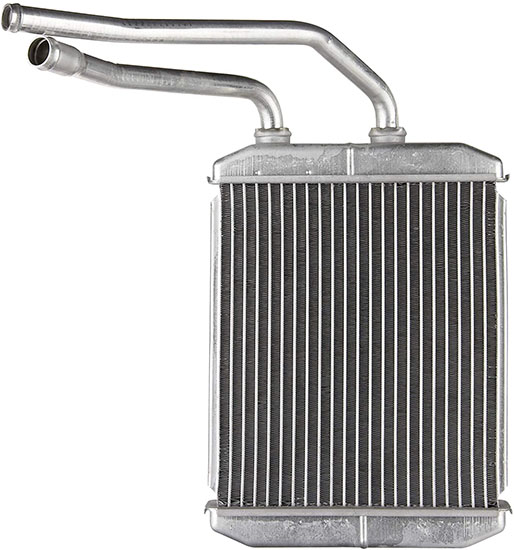
Like the radiator, the core is made up of conductive aluminum or brass tubing. Fins attached to the core tubes increase the surface area, thereby promoting the heat exchange to the air that is forced past the assembly by a multispeed fan, thereby heating the passenger compartment.
The fluid used to warm the heater core is the same as that used to cool the engine, with a water pump circulating the coolant in a closed system from the engine, through a thermostat to the radiator and back. In most applications the heated coolant for the heater core is tapped directly from the engine.
How The Heater Core Warms Up The Cabin

In the most basic heater layout, the hot coolant is redirected through the heater box in the cabin by activating an inline valve to divert the fluid. In this case the cabin temperature is commonly controlled by adjusting the valve to regulate the fluid flow-rate through the core.
Some manufacturers dispense with the valve completely, choosing instead to control the warm air passing through the core into the cabin, by means of the fan and a flap in the heater box ducting. Such flaps are commonly used to direct and control airflow to specific regions in the vehicle – such as the windscreen, passenger’s feet or upper torso. The system can be further refined by mixing cool outside air with that from the heater core, thereby offering occupants infinite temperature control.
See also: The Best Cabin Air Filters
In some larger upmarket vehicles, such as SUVs, manufacturers fit dual zone climate control systems with a split heater core, triggered by a temperature sensing fan. In this arrangement a blend-flap allows the front of the cabin to be regulated to a different temperature to that at the rear.
Taking this idea a step further, some high-end luxury models and three-row SUVs equipped with a divided heater core, allow rear seat passengers to individually control their temperature zones.
Keeping The System Working at Optimum Efficiency
Although the heater core itself is maintenance free it is part of the coolant system, and as such does benefit from routine servicing:
- The system should be flushed and recharged approximately every two years, or in accordance with manufacturers recommendations. It is important that when so doing the heater valve is opened and/ or the heater is switched on to ensure the heater core receives the new charge.
- It is also advisable to periodically inspect the coolant system for leaks, including the heater core.
But what happens if, despite regular inspection and servicing, the core or one of its assosciated components fail?
How to Spot And Repair a Faulty Heater Core
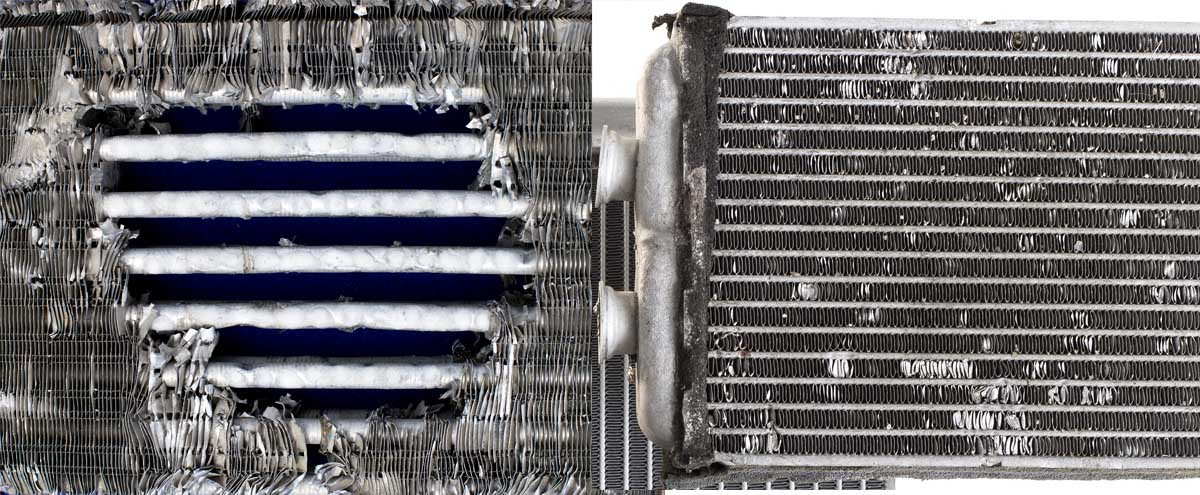
How does a driver spot a faulty core – Do the occupants merely loose some of their creature comfort in cold weather? And can it be repaired?
Signs That Indicate a Problem With The Heater Core
With only five key symptoms to look out for, a failed heater core is usually quite easy to spot:
1. No warm air coming from the vehicle’s vents – including the windscreen demister. This is a sure sign that the heater core, or one of the heater system’s secondary components is faulty:
- The heater core or one of the coolant hoses leading to the heater could be blocked. Much like the radiator the small diameter tubes in the heater core can become blocked if the system is not flushed and the coolant changed within the prescribed intervals. If these tubes are restricted, the flow of coolant will be disrupted and the capacity to heat the cabin reduced, or in severe cases, render the heater core completely inoperative. In the same way the control valve could become unserviceable – either stuck in the open or closed position.
- The flaps that direct and regulate the air may be faulty.
- The fan or electric switch/ temperature control may be defective.
2. Engine overheating – The temperature gauge in the instrument cluster shows that the engine is running hot, or even overheating, but there is no sign of a coolant leak emanating from the cooling system in the engine compartment. This could be an indication that the heater core or one of the feeder tubes is leaking. This is often caused by excessive corrosion as a result of electrolysis, and could be accompanied by other symptoms, such as the following.
3. Coolant leaking into the cabin – A wet passenger-side floor mat would be the first sign of a leak.
4. A fruity, sweet smell – a typical trait of ethylene glycol that is widely used as coolant – emanating from the vehicle’s interior or air vents could be an early sign of a leak developing.
5. Misted up windscreen – An oily film deposit on the inside of the windows above the windshield heater vent – very similar to the fog patches seen when the exterior temperature drops substantially below that of the cabin interior – could be a sign that coolant has leaked into the system’s ducting.
So what happens if the heater core is faulty? Can it be repaired or replaced? Can this be done by the DIY enthusiast?
Repairing a Faulty Heater Core
While a repair or replacement is definitely possible – because the heater core is usually located under the dashboard inside the passenger compartment, surrounded by ducting and enclosed in a housing with several flaps and actuators -this is best left to a professional or repair shop.
It is also not advisable to bypass the core, unless it is an emergency repair for a short period of time.
A bypass can usually be performed by locating the inlet and outlet hoses – typically found in the cowl area of the engine bay – and disconnecting them from the heater core. Using a suitable tube, or an appropriate heater core repair bypass kit, the faulty core can thus be bypassed. This will obviously render cabin warming inoperable as will it the demist function.
There is however, an even simpler temporary remedy – one which is cheap, quick and above all, can effectively be carried out by a novice without the use of any tools or equipment: This comes in the form of radiator sealant, also referred to as “radiator stop-leak”.
Although primarily intended to seal leaking radiators these products have been developed to the point where they can be used successfully to plug most leaks in a coolant system.
If following this route it is vital that the correct stop-leak is selected or the core can be irreversibly clogged. Thus it is important to stay with products with a good brand reputation. A coolant system sealer such as Bar’s Leaks versatile 1186 Liquid Aluminum Stop Leak is formulated to safely seal radiators, freeze-plug leaks, as well as gasket and heater core leaks.
For the best results the stop-leak should be applied to the coolant system as soon as a leak in the heater core is discovered – as the perforation expands over time, it becomes more difficult for the compound to seal the hole.
When using a stop-leak product it is best to treat this as a temporary repair, even though it could extend the service-life of the core indefinitely.
Finally; while the primary function of the heater core is to condition the cabin so that passengers can travel in comfort in cold weather, the consequences of a faulty or failing unit should never be overlooked:
- Without the heat provided by the heater core the driver will be unable to use the demister, thereby limiting their vision as the windscreen fogs up.
- A leaking heater core can result in overheating of the engine, leaving passengers stranded and the owner possibly faced with a costly repair bill.
The information discussed in this article is meant to furnish car owners with a better understanding of how the car’s heater system works and in particular the importance of the heater core and identifying problems with the unit.
We do an efforts to find, research and recommend the best products. So, we may receive commissions from purchases that you make after following the links in our product reviews.



